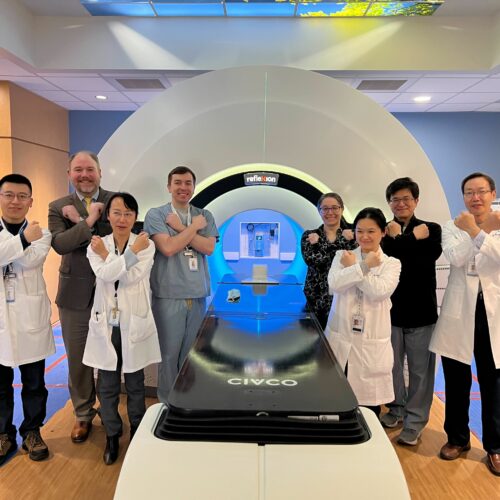
Press Releases
RefleXion’s New Sales Director Knows “Disruptive Tech”
April 19, 2021

“When we opened up this position, we were looking for someone who’s had a distinguished career in sales and who understands the radiation therapy field,” said Len Lyons, RefleXion’s vice president of sales. “Hector fit the bill and is a perfect complement to our team. We are looking forward to working with and learning from Hector, and I am thrilled to have him join us.”
“I love selling innovative technology and breaking into and developing new markets,” says Ruiz de Vinaspre. “I’m excited to be part of this breakthrough initiative and I was impressed with everyone I spoke with on the RefleXion team.
“I was drawn to the company’s commitment to improving outcomes for metastatic patients,” he continues. “I like the idea of contributing to a mission to move the needle for late-stage cancer. I also appreciate how the technology was built from the ground up over 10 years with the aim of precisely and efficiently treating many lesions throughout the body.”
Ruiz de Vinaspre’s 25-year career has primarily been in sales in the medical device industry. After graduating from NC State University with a degree in Business Management, he got his first job working as a client representative at IBM. He then became an area sales manager for Brainlab, the German-based company that sells intelligent, software-guided technology for surgery and radiotherapy. He helped launch Brainlab’s orthopedic navigation business and its Integrated OR suites, where diagnostic CT and MRI are brought into the surgical theater to guide procedures. In 2010, he became a regional sales manager for Calypso Medical (Varian), maker of an implanted transponder used to localize and track tumors in real-time during radiotherapy. In 2012, he was recruited by ViewRay to be senior sales director, just as the company was preparing to launch the first clinical MR-guided radiotherapy system. In 2019, he joined Elekta to lead the company’s North America MR-Linac Business Line.
“Each technology I’ve been involved in has offered new ways for the clinical teams to tailor and guide their treatments,” Ruiz de Vinaspre says. “I saw RefleXion as a natural evolution towards an innovative guidance system rooted in PET/CT—the gold standard for cancer staging and imaging—that could ultimately have a big impact in the metastatic setting.”

Hector and his family
Over his career, Ruiz de Vinaspre has witnessed considerable advancements in cancer treatment, notably the move towards personalized medicine and tailored treatments. Cutting-edge technologies and advances in drug treatments—primarily immunotherapy, which “fires up” a patient’s immune response—in the past decade have helped clinicians and researchers make tremendous strides in personalizing cancer care. “Interdisciplinary collaboration will continue to increase, especially as it relates to metastatic disease,” Ruiz de Vinaspre says. “We have seen great results in trials treating oligomets with combination therapies, but these protocols are typically limited to 1 or 2 sites of disease because of technological and logistical challenges. These ongoing, positive results support our premise of combining systemic/immune therapies along with local ablation of all sites of disease.”
Ruiz de Vinaspre explains that when using CBCT or MRI, a full image set is acquired and then used to guide the treatment with that image. “When RefleXion’s biology-guided radiotherapy (BgRT)* becomes available, it will eliminate the need to wait for a full PET image to form because the injection of the tracer “lights up” the tumors using just partial image data; they immediately start signaling their location, and the system reacts to direct radiotherapy at the tumor. We believe this concept could allow for the treatment of multiple targets in the same treatment session.
“We are developing technology with the ability to deliver a tracked radiation dose in real-time, in order to potentially produce a fast and efficient treatment regardless of the number of sites of disease,” Ruiz de Vinaspre continues. “At the end of treatment, we will have a full PET image, and a CT image, that we can potentially use for quantitative metrics as we develop radiomic assessments to help tailor individual treatments. The more data clinicians have, the better because they can be more precise in developing a treatment plan for each patient.”
MR-based radiotherapy has improved cancer treatment. “There is a need for both MR and BgRT, and I see them as complementary,” says Ruiz de Vinaspre. “What excites me most about BgRT is the unique potential to open up a new service line, so cancer centers are able to offer a therapy they do not have today. A true win-win for patients and cancer centers.”
“Hector understands our market space and will bring an expanded viewpoint to our sales strategy,” said Lyons. Ruiz de Vinaspre explains it’s a promising time for cancer centers and patients because there are more technology and treatment options. At the same time, it’s challenging because of fiscal pressures on hospitals brought about by COVID 19. “It’s my job to inform RefleXion’s existing and future customers about the X1’s capabilities and how we can partner with them to help them meet their strategic goals,” he says.
Ruiz de Vinaspre is excited about the future of cancer care and invigorated by this new professional opportunity. “I’m excited about being in the startup world again, with small, nimble teams,” he says. “I have a lot of respect for my colleagues and the team at Reflexion. I see a new era and a new possibility to make a meaningful impact—as measured by overall survival—in metastatic cancers. That’s why I’m here, and I love the fact our clinical affairs team is designing trials to measure the impact of our technology on patients’ lives.”




